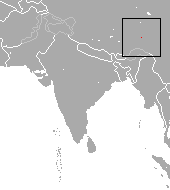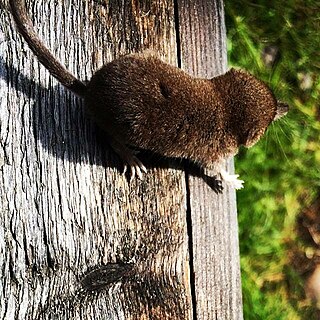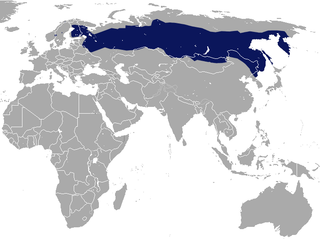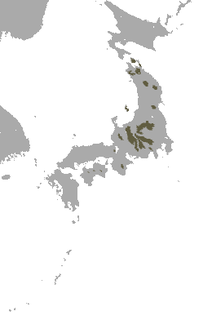
The red-toothed shrews of the subfamily Soricinae are one of three living subfamilies of shrews, along with Crocidurinae and Myosoricinae. In addition, the family contains the extinct subfamilies Limnoecinae, Crocidosoricinae, Allosoricinae and Heterosoricinae. These species are typically found in North America, northern South America, Europe and northern Asia. The enamel of the tips of their teeth is reddish due to iron pigment. The iron deposits serve to harden the enamel and are concentrated in those parts of the teeth most subject to wear.

The smoky shrew is a medium-sized North American shrew found in eastern Canada and the northeastern United States and extends further south along the Appalachian Mountains.

The genus Sorex includes many of the common shrews of Eurasia and North America, and contains at least 142 known species and subspecies. Members of this genus, known as long-tailed shrews, are the only members of the tribe Soricini of the subfamily Soricinae. They have 32 teeth.

The Eurasian pygmy shrew, often known simply as the pygmy shrew, is a widespread shrew of the northern Palearctic.

The Asian house shrew is a shrew species native to South and Southeast Asia that has been listed as Least Concern on the IUCN Red List since 2008 because of its large population and wide distribution. It has been introduced in several West Asian and East African countries. It is considered an invasive species and implicated in the demise of several island lizard species.

The Gansu shrew is a red-toothed shrew found only in a small part of Gansu province and other adjacent areas of China. With its very limited range, it is sensitive to habitat loss and is listed as a "vulnerable species" in the Chinese Red List, while the IUCN lists it as being "data deficient"

Kozlov's shrew is a red-toothed shrew found only at the Mekong River, Tibet, China. It is listed as a data deficient species.

The Ussuri white-toothed shrew is a species of musk shrew found on the mainland Northeast Asia. It is common and widespread, and is one of the largest shrews found in the region, with adult weight of 14–25 g (0.49–0.88 oz). It should not be confused with the related Ussuri shrew.

The long-clawed shrew is a species of shrew. An adult long-clawed shrew has a weight of less than 20 grams (0.71 oz) and a body length of 54 millimetres (2.1 in) to 97 millimetres (3.8 in), with a tail of 40 millimetres (1.6 in) to 53 millimetres (2.1 in). It is distributed through the uplands of northeastern Asia, including northeastern North Korea.

Laxmann's shrew, or the masked shrew, is a species of shrew. Its range extends from northern Scandinavia and the Baltic to the Sea of Japan, including Hokkaidō, Sakhalin, and the Korean Peninsula. It favours mountain forests but is sometimes found in tundra and moorland, and also in lowland areas as well. It avoids cultivated land.

The Ussuri shrew, also known as the giant shrew, is a species of shrew found in Northeast Asia. An adult Ussuri shrew has a total length including the tail of 137 to 170 mm. It is found in valleys and on the forested slopes of mountains in the Korean Peninsula, northeastern China, and the Russian Far East. It is rarely observed, and its ecology is largely unknown.

The Siberian large-toothed shrew is a species of shrew. An adult Siberian large-toothed shrew has a weight of 4.6–6.0 g (0.16–0.21 oz) and a body length of 5.5–6.4 cm (2.2–2.5 in), with a tail of 2.4–3.8 cm (0.94–1.50 in). This species is found across Northeast Asia, from Mongolia through northeastern China to the Russian Far East and the Paektusan region of North Korea.

The slender shrew is a species of shrew. An adult slender shrew has a weight of 1.5–5.3 g (0.053–0.187 oz) and a body length of 4.7–6.0 cm (1.9–2.4 in), with a tail of 4–5 cm (1.6–2.0 in); this makes it one of the smaller shrews found in its range. It is distributed across northeastern North Korea, Hokkaidō, and the Russian Far East including the Kuril Islands.

The taiga shrew, also known as the even-toothed shrew can achieve a body length of about 67 millimeters, with a tail of about 43 millimeters. This shrew is very similar to the long-clawed shrew. This species inhabits forested mountain valleys, and is found across northern Eurasia. It ranges from the Baltic Sea area through the Lake Baikal region of Siberia into the Russian Far East and along the Baekdudaegan mountains of the Korean Peninsula.

Baird's shrew is a species of mammal in the family Soricidae. It is endemic to northwest Oregon. Baird's shrew inhabits moist conifer forests.

The Azumi shrew is a species of mammal in the family Soricidae. It is endemic to Japan, where it is found in the mountainous regions of central Honshu Island. It is a close relative of the Eurasian least shrew. It is threatened by habitat loss.

The Saint Lawrence Island shrew is a species of mammal in the family Soricidae. It is found only on Alaska's St. Lawrence Island.

The Shinto shrew is a species of shrew of the genus Sorex that lives only on the islands of Japan. It is a mole-like mammal with a pointed snout, very small ears, and a relatively long tail. Like most shrews, it is tiny, has poor eyesight, and a very good sense of hearing and smell which it uses to locate its prey, mainly insects.

The Chinese shrew or dusky shrew is a species of mammal in the family Soricidae. It is endemic to China, where it occurs in Gansu, Sichuan, and Shaanxi. Its natural habitat is subtropical or tropical dry forest.

The Inyo shrew is a species of shrew found in the western United States. Not much is known about its behavioral and reproductive habits. It is small, very similar in appearance to the related dwarf shrew, but smaller and paler. It can be found in many different habitats, from rocky, mountainous regions to wetlands and riparian areas. While barely studied, their population is believed to be stable and not under any threat.




















